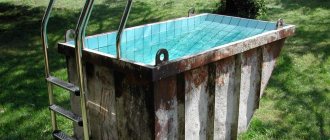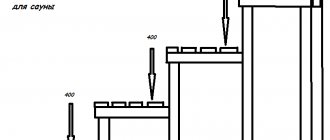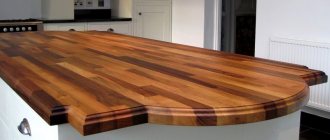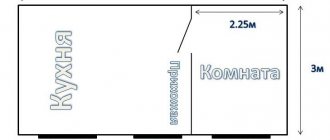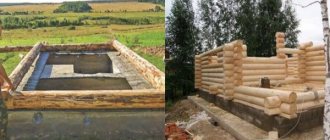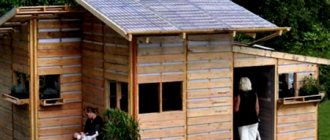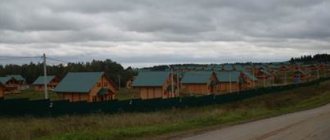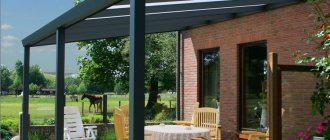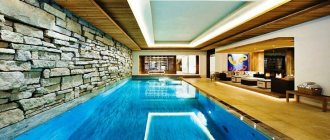How to build a stone pool? Find out how to make a stone pool with your own hands in our article.
Pools made of rubble or pebbles usually play a decorative role and decorate the area as an artificial small reservoir. But if you decide that your pool will be exactly like this, then this idea can be brought to life.
The cost of rubble stone varies from 880 to 1,500 rubles/t.
We finish with digging a hole for the pool
Dig a hole deep and make the edges
Removing the remaining soil
Please note that at this step we are laying a mound of earth, which will later serve as a structure for a waterfall, which we will install along with a pool on our summer cottage.
Construction stages
- The construction of any in-depth pool bowl begins with choosing a location and marking the pit. The walls of the pit are dug at an angle towards the outside.
- If the bowl is designed with protruding sides, then you need to mark its base. Level and remove the top layer of fertile soil.
- Preparing the pit. A cushion is placed at the bottom of the pit in layers of sand and crushed stone. The layers are compacted.
- A waterproofing material in the form of a film is laid on the soil. The upper edge is secured with stones.
- The stones are laid at an angle on the wall of the bowl. They are attached to each other on a sand-cement base with water-repellent properties.
- For a more durable structure, formwork is made from reinforcement and boards.
- The necessary mortgages are laid for drainage, lighting, etc.
We bring pipes under the pool
Fill the hole with sand and connect the pipes to the pump
At this step, we will need to sprinkle the pool with sand and install pipes that will allow us to organize a waterfall on our summer cottage. It is installed very simply and works through a pump, which in turn is powered by electricity. The pump will pump water from the pool and lift it up our slide and work according to this cycle.
How to decorate?
Decorating a decorative pool is the prerogative of the owner. As a rule, they imitate natural reservoirs in different climatic zones.
The most successful design is one that is as close as possible to the conditions of the region - this way the garden pond looks appropriate at any time of the year and does not take on an awkward appearance (for example, artificial palm trees among snowdrifts).
Photos of decorative pools can be seen below:
Covering the pool with stones
We prepare stones
Preparing stones is probably the most difficult stage of all our work. It can be quite difficult to find a stone of suitable length. A good option would be to go to the river bank and collect stones there, but there are mostly pebbles there, but it’s your choice. If you don’t know where to find stones, then we advise you to purchase them at special construction stores.
We begin to lay out stones along the contour
We lay out an alpine slide of stones
Having previously leveled the pile of earth, we begin laying out the stones, but here it all depends on your imagination.
We finish with laying out stones around the pool
This is what our pool will look like after laying out the stones, now let's move on to the next stage - adding crushed stone to the bottom of the pool (on the rubber).
We lay crushed stone on the bottom of the pool
Filling the pool with water
After the gravel is covered, fill it with water. Please note that the stone must be washed well to prevent your pool from becoming dirty after filling.
What it is?
A decorative pool is an artificial reservoir that imitates a natural lake or small pond. It is installed open to create the most natural look.
As a rule, such a pond has a purely decorative purpose, although some owners use such bowls for their intended purpose (for swimming and active recreation). Many users breed fish in such pools and add poultry to them.
The specifics of a decorative pool require proper design of not only the bowl itself, but also the entire surrounding area, creating an imitation of a wild natural reservoir.
Landscape design techniques are used here, stone boulders and sand mounds are installed, and plants are planted. Attention! In pursuit of decorative possibilities, one should not forget about safety. Creating wild landscaping can cause children or pets to fall into the water. This must be foreseen in advance in order to protect your household and pets as much as possible.
Connecting the pump to the alpine slide
Connecting the pump to the pool
For our unit from which water will flow, we chose an ordinary jug, you will agree - this gives some zest to our country pool.
Do-it-yourself Alpine slide at the dacha - finished look
The pool with an alpine slide is ready, all that remains is to build a small botanical garden around it, but that’s a completely different story, which we will share with you in the next lessons from StroyVopros.net. If you have any questions, ask them in the comments.
How to make a garden decoration with your own hands: step-by-step instructions
You can use various containers or coverings to create the look of a mountain lake or a tropical lagoon. At the same time, the overall creation process is divided into general stages, which should be considered separately.
Design stage
At this stage, it is important to harmoniously combine technical and decorative aspects to ensure the attractiveness and functionality of the pool.
It is necessary to determine the parameters of the reservoir:
choose a location taking into account the need to design the area around the bowl;- decide on the size (it depends on the size and configuration of the site);
- resolve the issue of materials from which the bowl will be built;
- draw up a layout of communications and equipment (if the water will circulate and undergo filtration).
Materials for manufacturing can be:
- polyethylene (or vinyl) film covering a regular depression in the ground;
- plastic bowl (usually a ready-made composite pool is used);
- reinforced concrete bowl;
- an eco-pond, which is a depression in the ground with a bottom reinforced with a layer of clay (experts call it a clay castle).
You can also arrange for the reservoir to be recharged with rainwater and create a small ditch to drain the excess. If it rains frequently in the region, the water will be constantly renewed, the bowl will not silt or become overgrown with algae.
Important! When choosing a place for a decorative pool, it is not necessary to look for an open area with a flat topography. In this case, you can take advantage of the folds of the relief and play up the presence of trees or large boulders on the site.
Tools and materials
To make a pool, you will need tools and materials that match its design and size.
Standard set of tools:
shovel, pickaxe, crowbar;- wheelbarrow for removing soil;
- measuring instruments (tape tape, building level, ruler);
- quarry sand and cement (for building a concrete bowl or pouring a nest for a composite pool);
- fittings (it is best to use metal corrugated rods 10-12 mm);
- boards for assembling formwork;
- vinyl film for finishing the bottom and sides (it is also useful for creating the simplest option);
- sharp knife;
- construction hair dryer for welding film;
- concrete mixer and container for preparing the mixture.
Listed are the tools and materials needed to make different reservoirs. However, the creation process is unique in many ways. Other materials and tools may be required to complete the work
Manufacturing process
Making a decorative pond is a task that is solved in accordance with the specifics of the project. The process of building a small reservoir and a large bowl are significantly different from each other and require different construction methods and design.
Reference! A large bowl can be used as a full-fledged pool, but small bodies of water, as a rule, perform purely decorative functions.
small pond
Building a small pond does not require much expense or effort. Procedure:
The area allocated for the construction of the pool is being marked.
Since the shape of the reservoir is usually irregular, close to an oval, it is enough to mark the boundaries of the reservoir and not level or level the site.- Dig a pit or depression slightly greater than the planned depth of the pool. Its shape is usually made close to natural - a smooth decrease in level to a maximum at the central point.
- Large pebbles (10-15 cm) are placed at the bottom of the bowl to strengthen the banks and strengthen the soil. A layer of sand is poured on top to smooth the tops of the stones and level the bottom of the bowl.
- Lay vinyl film. Its edges should protrude beyond the bowl (they are hidden under a layer of backfill).
- Fill the pool with water.
This pool design option is not designed to use a filtration system or communications for draining water. Since the depth of such bowls is small, and the purpose is purely decorative, water purification is carried out using natural methods. It is recommended to place fish in the bowl and monitor the water level - in the summer heat it can dry out.
The video below explains how to build a small decorative pool with your own hands:
Big bowl
It makes sense to build a large bowl not only for decorative purposes, but also for practical purposes. The best option is a reinforced concrete bowl with utilities and connected equipment.
Construction order:
- Markings are made and a pit is dug. Its depth must correspond to the design size of the bowl plus the thickness of the bottom and the sand backfill layer. In addition, trenches are immediately dug for communications (water supply and drainage), as well as for connecting circulation equipment.
- A sand cushion (quarry sand or PGS) 15-20 cm thick is poured onto the bottom of the pit. It is compacted and covered with a layer of geotextile.
- Assembling the formwork. Polyethylene waterproofing is laid inside, then a reinforcement frame is tied and installed in the formwork.
- Concrete is poured and allowed to stand for 2 weeks before removing the formwork. After this, the casting is kept for another 14 days.
- Fill the bottom of the pool or lay ready-made slabs and pour a layer of screed (a faster option if the size of the bowl allows it).
- Utility systems are connected and trenches are filled.
- Decorative finishing of the bowl is carried out taking into account the design solution. At the same time, the circulation equipment is connected.
- The bowl is filled with water and the functionality of the systems is checked.
Important! The indicated diagram is only a general order of work. A more accurate list of operations can only be made on the basis of a finished project.
What equipment will be needed?
Equipment is needed only for a large pool.
It contains a large volume of water, which without purification will bloom, and the bowl itself will gradually turn into a swamp. Therefore, from the moment the project is created, it is necessary to lay down the installation of the circulation piping, which includes:
- circulation pump;
- sand filter;
- pipelines and shut-off valves.
In addition, you will need to connect the bowl to the supply and discharge pipelines, for which you will need the pipes themselves and shut-off valves.
Pros and cons of this cladding option
The advantages of finishing a pool with stone include:
strength, reliability of cladding;- attractive appearance of materials;
- large selection of natural or artificial stone;
- the ability to combine different types of finishes;
- durability, high maintainability of the cladding;
- The material resists moisture well, easily withstands temperature changes and mechanical stress.
The disadvantages of finishing pools with stone include:
- for finishing it is necessary to attract specialists with experience and skills in such work;
- some types of stone react poorly to acidic components in water and are also difficult to process;
- the cost of materials and labor is very high, which limits the popularity of this type of finish.
Modern Design Styles
Most often he uses four directions for decorating a pool:
- Classical. Typically, materials such as paint and decorative plaster are used.
- Art Deco. Colored mosaics and reflective surfaces are actively used.
- Ethno. The space is designed based on the traditions of a particular people.
- Country style. Natural materials are used: natural stone, wood, living plants.
You can put a TV and sun loungers near the pool
A swimming pool in the yard will save you from the heat
See also3D panels in the interior: photos, installation, pros and cons
Various containers
Ponds are used as a landscape object, that is, only for decoration, as a pool for fish breeding, and even as a pond for swimming. Accordingly, the size and shape of the products will be different.
Possible forms
- As a rule, they try to make the shape of reservoirs as irregular as possible, since it should imitate a natural pond.
- Small pools have a regular round or oval shape, built with the aim of emphasizing the garden landscape, and not making it look like a natural park.
Dimensions, depth
Since the configuration of an artificial reservoir is often quite complex, the system for indicating dimensions here is somewhat different from the usual one.
- Depth – ranges from 30 cm to 300 cm. The largest parameter value is always indicated. If the shape is rectangular, then the depth is the same over the entire area; if it is multi-level, then such depth is noted only in one area.
- The width and length of the product are indicated by the dimensions of the widest part. For example, a popular size for a small pond 124 * 90 * 58 by 250 l has an approximate oval shape with a narrowing in the middle (like a figure eight), and a width of 90 cm is indicated for the wide part of the product.
The figure eight shape with various contours is very popular, as it is very easy to transport and has greater depth. A garden pond 310*280*90 with a volume of 270 liters, for example, from the same manufacturer, is made in the shape of a symbolic flower. At greater depths, it is actually shallower, since such a complex configuration requires a larger area of shallow depth areas.
A swimming pool with a water surface area of more than 10 square meters. m. and a depth exceeding 1 m, suitable for fish farming. For example, for carp and crucian carp a depth of 1.5 m is sufficient, but for trout and sturgeon, since they are more demanding of the oxygen content in the water, a depth of 2–2.5 m is needed.
In this case, a cascade arrangement of sections of different depths is a necessity. Firstly, the embossed bottom does not allow food to roll to the very bottom and accumulate. And secondly, it makes it possible to breed several types of fish.
This material will tell you what to feed crucian carp in a home pond.
Where is the best place to place a swimming pool in the country house and garden?
When building a stationary pool, choose the least mobile area of soil without groundwater, and if there is a bathhouse, the area next to it.
As a rule, stationary tanks are made in medium and large sizes.
A prerequisite for any pool is a sunny place. Mobile options should not be placed on lawns; due to the lack of air, fungus forms, the grass dies and rots.
The place for the pool should be clearly visible from different points to be able to monitor vacationers for their safety.
The minimum set of actions - water supply, its purification and subsequent drainage - must be organized using special equipment.
Reviews
- Oleg, 33 years old, Nizhny Novgorod: “My wife has long wanted a pond in the garden. But there is no way and nowhere to fence the concrete bowl. I saw these ready-made plastic forms purely by accident. I dug the trench myself and installed the filters myself. Well, Marina planted all sorts of flowers.”
- Ekaterina, 28 years old, Ivangorod: “We had the first pond in our garden from the bathroom. And three years ago they replaced it with a plastic mold, a German one. It is larger, multi-tiered, and looks, by far, more beautiful. I have water lilies living in it.”
- Elena, 42 years old, Borisoglebsk: “We not only made an artificial pond on the site, but even with streams. True, they lined the banks themselves anyway; I didn’t like the finish on the sides. It turned out very beautiful. It’s been standing for almost 5 years already.”
A ready-made garden pond is a great opportunity to equip a small or even large pond without resorting to major renovations on your site. A variety of shapes and colors, as well as the presence of any additional elements - filters, pumps, purifiers, allow you to choose a model for any landscape.
Maybe
Pool finishing features
The stone for cladding is chosen according to your wishes. Granite or marble, travertine or lithoceramics - we offer you to get acquainted with their samples on the website or in one of our showrooms. If you find it difficult to choose, invite our designer, he will offer several options. For example, a swimming pool with a bowl lined with marble or granite in greenish-blue shades looks great. In this case, the water surface becomes attractively beautiful. A similar effect is achieved by mosaics, which also create an atmosphere of incredible luxury and wealth.
When finishing, we use large-sized tiles - this way the number of seams when laying them becomes minimal, and the structure itself is significantly strengthened. The tiles are specially treated: their rounded edges do not pose any threat during bathing.
In each case, the pool is equipped with sides, curbs, and wide paths made of rough stone - this eliminates the risk of falling when exiting the water.
An additional decoration for a pool, especially an outdoor one, can be small fountains, mini-baths, flowerpots and other exclusive products from JazzStone.
Tips and recommendations for using swimming pools in landscape design of a site
Almost any site can imply the presence of a swimming pool. It is important to choose the right model, manage funds wisely, connect your own labor reserves, and take into account the necessary functions. A wide range of finished products will greatly simplify the task.
Pools made of composite materials are considered the most durable and resistant to various climatic conditions.
When choosing a deep pool of increased comfort, the help of specialists will come in handy; the result will please its owners.
If you need an exclusive design of a swimming pool for your dacha, you will have to build it yourself. It will be expensive, but original, respectable and unique.
Popular models
Frame models, due to their large size and depth, are suitable for adults. Inflatable pools are usually purchased for children's recreation.
Frame
A frame structure is a frame with a bowl installed on top of it. This tank is more difficult to install and requires preparation of the site for it.
Usually has a rectangular and round shape.
Models of small frame pools for summer cottages:
- Intex 28271, 160x260x65 cm. Volume – 2282 l. Depth – 65 cm. Cost – 7000 rubles.
- Intex Metal Frame 28200/56997. Round tank. Diameter – 305 cm. Depth – 76 cm. Volume – 4485 l. Cost – 8200 rubles.
- Bestway Rectangular Power Steel Frame 56241/56456. Length – 412 cm. Width – 201 cm. Depth – 122 cm. Volume 8700 l. Cost – 33,000 rubles.
Inflatable
This type is a soft bowl that, when filled with water, takes on the shape of a cylinder. The model is easy to install and easily transported from place to place.
Models of small inflatable pools for summer cottages:
- Intex Swim Center 58484. Length – 305 cm. Width – 183 cm. Depth – 56 cm. Volume – 1092 l. Cost 2700 rubles.
- Intex Easy Set 28142. Round tank. Diameter – 396 cm. Depth – 84 cm. Volume – 7290 l. Cost – 8900 rubles.
- Intex Easy Set 28120/56920. Round tank. Diameter – 305 cm. Depth – 76 cm. Volume – 3853 l. Cost – 4000 rubles.
How to arrange and decorate
The most commonly used natural stones are sandstone, slate, flagstone, and so on. When designing the shore, you should pay attention to the size of the stone: a small pond against the background of large stones will “get lost”, in this case it is better to use ordinary gravel. But for large pools you can use large serpentine cobblestones, for example.
How a waterfall pump works in a country house is described here.
If desired, the reservoir is populated with plants, but at the first stage it is recommended to pay more attention to coastal ones: they take root less well.
Here, too, it is important to maintain a reasonable balance. Foliage from large plants quickly clogs the pond; it will have to be cleaned frequently, especially in the fall.
It is worth planting moisture-loving plants around the pond. It is better to avoid blooming ones. It is recommended to consult with a specialist before choosing and planting plants. No matter how small the population of an artificial reservoir is, it is important to maintain a balance in it.
Read more about carp breeding at home at this link.
For owners of a stationary pool.
For owners of a permanent pool, there is good news. Let's say you built your pool many years ago. You spent many wonderful hours there and have positive memories of those times. But you wanted something new. But what to do?
But what! Since you already have a pond, all you have to do is purchase large stones and decorate your pool into a beautiful natural corner.
You can also additionally install a fountain or waterfall through which water will flow and caress your ears.
Of course, you won’t get a large area, but your old pool can change dramatically and acquire a second youth.
This is basically a way out of the situation. A garden pool is an integral part of your holiday. But what kind of pool you should build is up to you to decide.
Which color to choose
Although plastic can be of any color, garden ponds are most often offered for sale in three colors:
- black - they seem deeper (if properly designed, the bottom is almost invisible) and reflect the sky well. Most often used for constructing decorative ponds;
- blue - in these you can see the bottom, the sky is reflected by 20%. Best suited for constructing swimming pools and baths, the water in them seems cleaner;
- green - the bottom is faintly visible, reflection - 50%. Ideal for fish breeding and planting.
In our market, which unites large online stores, you can find everything you need to care for your pond. Take a look at the sections Pond care products, Pond accessories, and the selection of Preparations for pond transparency.
Principles of lighting artificial reservoirs
Lighting plays a key role in the design of all types of pools. The two most popular directions are:
- classic style;
- decorative approach.
Classic lighting will create a soft light that will give the pool an absolutely natural look at night. A decorative approach will allow you to play up the design features of an artificial reservoir; such lighting will look especially advantageous in a non-rectangular pool for zoning individual areas. Decorative light can be combined with musical accompaniment, which will give the design of the reservoir even more originality.
Recently, LED lamps with increased protection and reliable sealing to avoid contact with water have become popular. To create a unique room or garden landscape, you can combine the lighting of the pool and the surrounding area.
A pool in the house is a great idea
You can add steps to the pool
See also Bathhouse interior
Types of ready-made forms
Garden ponds are made from various types of plastic, since this material is waterproof, does not corrode, and is not very sensitive to low temperatures.
- Polyethylene - small reservoirs with a volume of 130 to 900 liters are made from plastic. They are designed for 10 years of operation, are quite durable, and resistant to ultraviolet radiation. However, the material does not tolerate repeated bending, and cracks that occur cannot be repaired.
- Polypropylene - differs from the previous version in being much more resistant to bending. This property extends the life of the product – up to 20 years. Installation is allowed on surfaces with shallow relief. You may also be interested in a polypropylene pool bowl.
- Fiberglass - or fiberglass, a composite material of organic origin. It has very high strength with low weight. Ponds with a large volume and a depth of more than 1.5 meters are made from fiberglass. The durability of the material exceeds 30 years. Fiberglass pool edges are often coated with a stone finish to give the product a more natural look.
Plastic pools not only do not need to be put away indoors for the winter, but it is not even necessary to drain the water from them.
You will find all the information about fish farming in artificial reservoirs here.
Natural attractiveness
The pool is a decorative pond. A landscape in a classic style looks organic with pools of regular geometric shapes: round, oval, square, rectangular. The landscape gives plenty of room for imagination. Decorative pools can be of any irregular shape or with curved edges. When building and arranging a decorative pool, you can take advantage of the terrain features.
On a hilly area, a decorative pool with a cascading waterfall will look beautiful. On flat terrain, a pond can be lined with shrubs, water-loving plants (reeds, calamus, sedge), and decorated with braid. It is not recommended to plant tall trees with a strong root system near an artificial pond. In autumn, leaves from trees will fall into the water. The roots, growing, will begin to destroy the walls and bottom of the pool. If you really want to landscape an area with a decorative pool, it is better to plant low bushes or a dwarf willow near its banks. The crown of the tree will not create dense shadow.
Where and approximately at what price can I order the service?
Pool lining can be performed by any specialized organization working in this profile. You can contact ordinary builders, but there is always a risk of contacting inexperienced people who have not previously performed such work.
The average cost of lining a bowl is from 5,000 rubles. per square meter , which often makes you think about finishing it yourself. In this case, all costs will be charged only to the purchase of the material, which is also not cheap.
For example, marble tiles will cost from 2800 rubles/m2 to 8600 rubles/m2 (depending on the size, thickness and quality of the surface). Granite cladding costs about the same.
Outdoor pond – design ideas
An outdoor pool is more suitable for the southern regions of the country, where there are no long periods of winter frosts, so there is no need to waste resources on heating, which should prevent the water from freezing. Another disadvantage of an open reservoir is excessive water pollution with leaves, dried grass and other natural debris. For the temperate climate of most of Russia, prefabricated artificial reservoirs in the open air are suitable.
To design the coastal zone, frost-resistant materials are used: wood, paving slabs or natural stone. The design of an outdoor pool certainly includes living plants: trees, shrubs and flowers, which are best placed not only next to the pond, but throughout the entire garden plot. It is better to plant plants whose flowering period occurs in different months. Then the area around the pool will look cozy and beautiful for a long time.
Pool finishing can be made from mosaic tiles
This pool will save you from the heat
It is best to finish the pool with blue mosaic tiles
See alsoDecor for Valentine's Day
